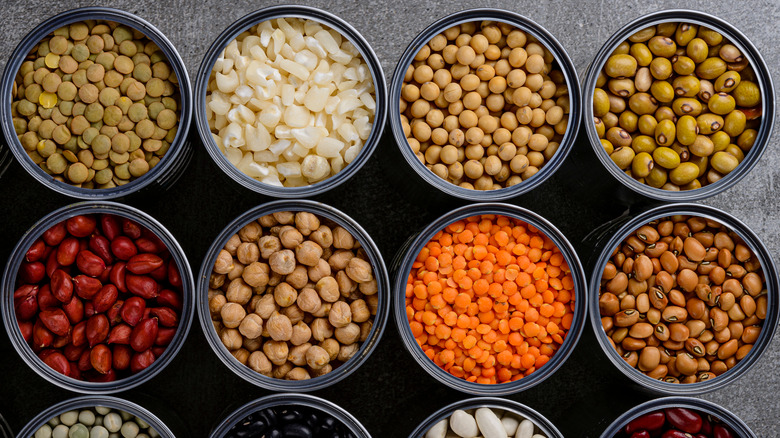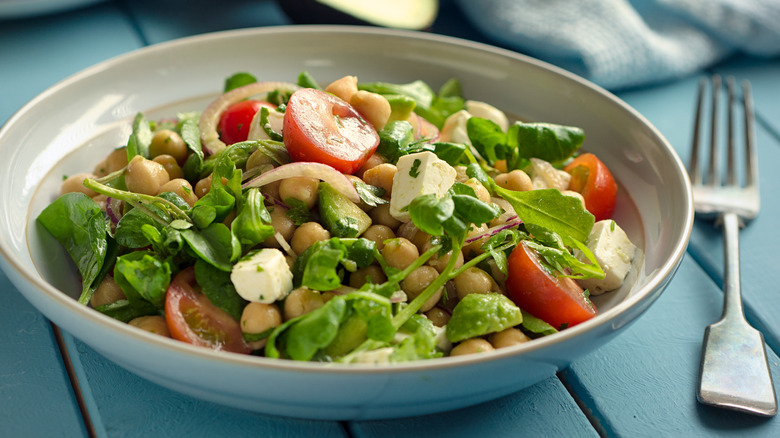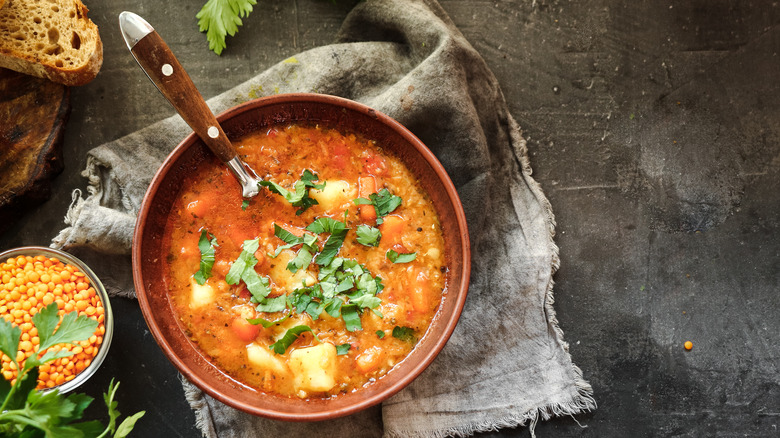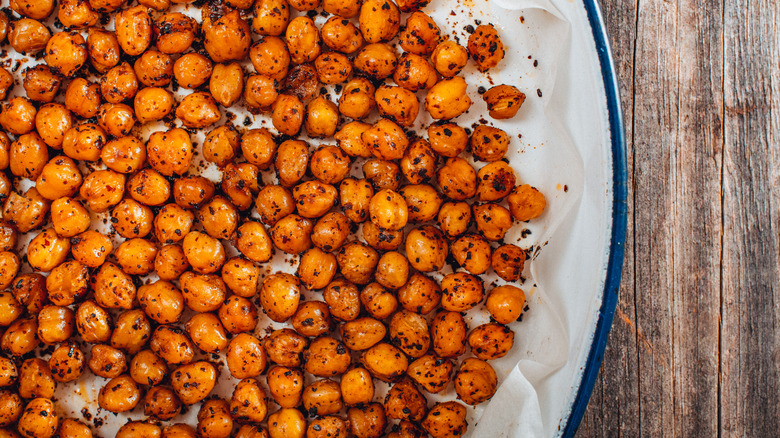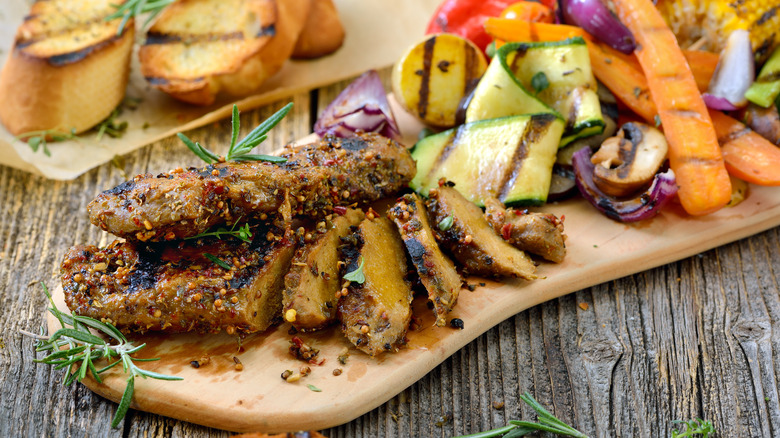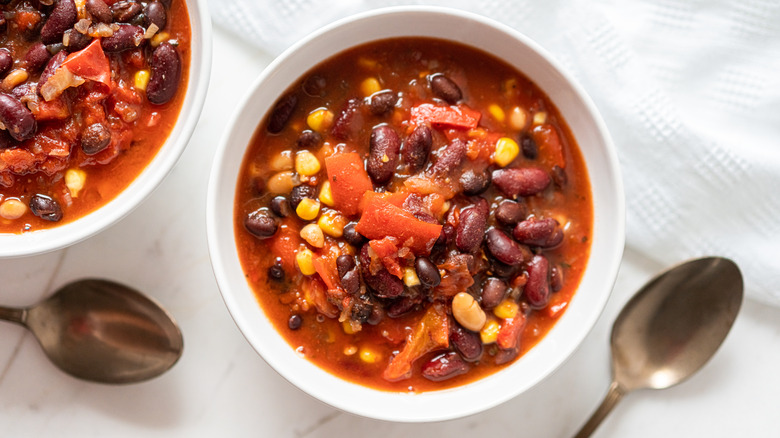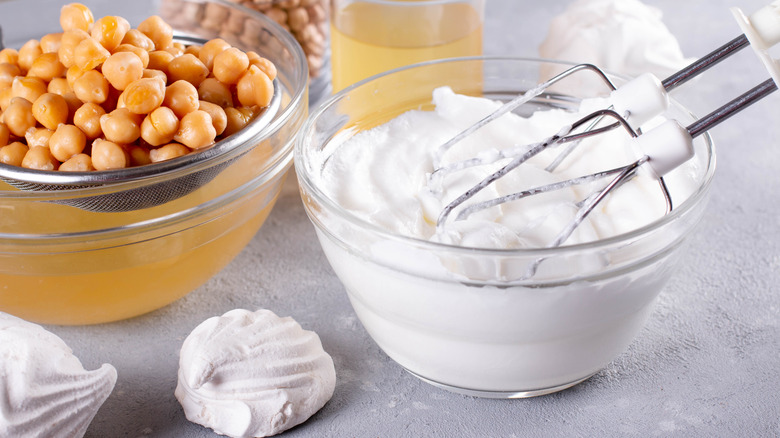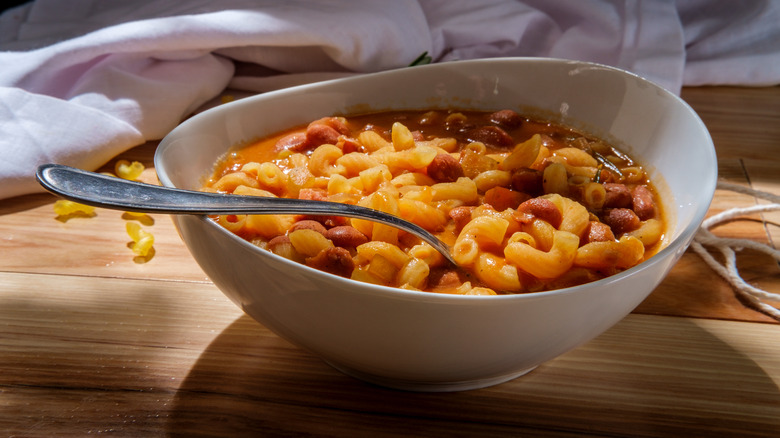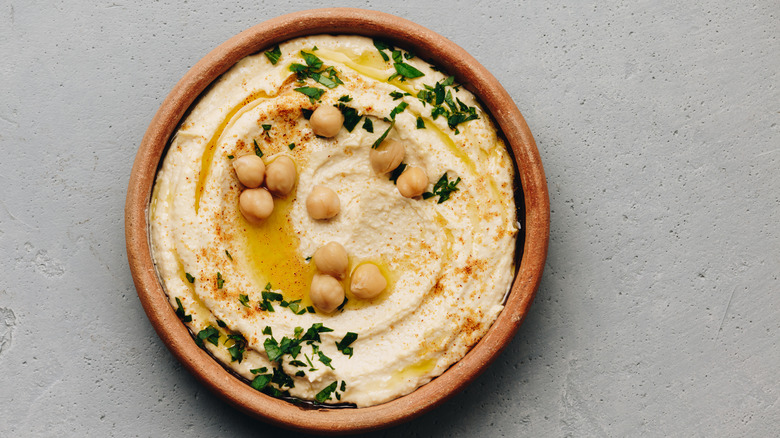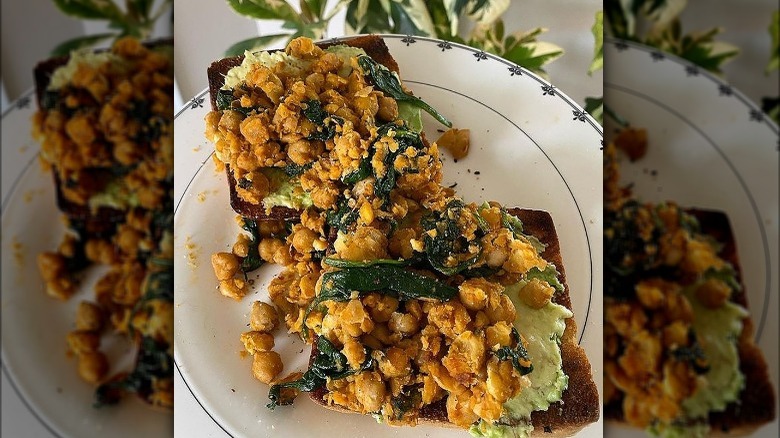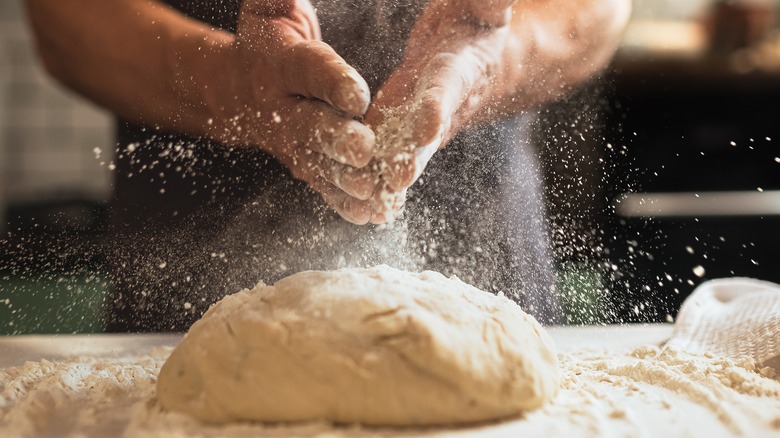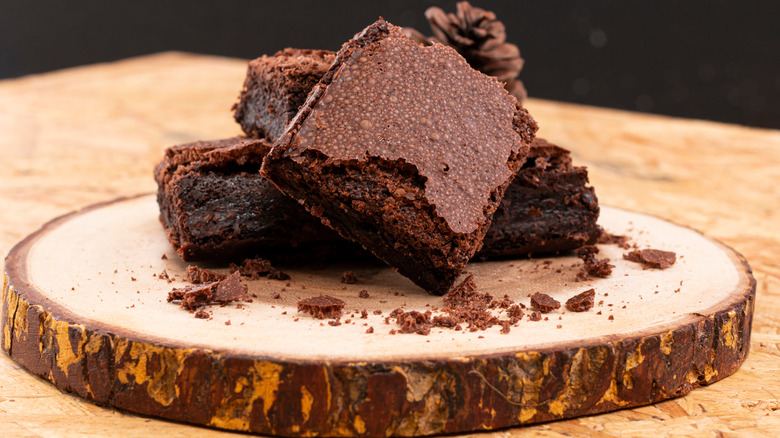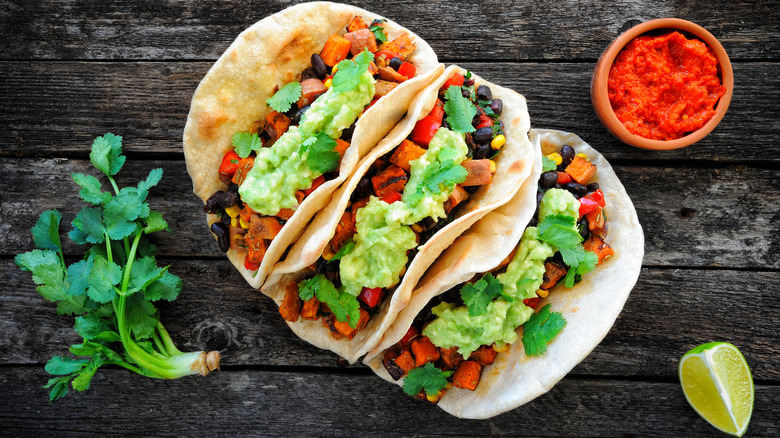12 Things You Should Be Doing With Canned Beans And Lentils
If you are ready to discover the secret to whipping up delicious meals in a flash and want to learn novel ways to use the humble legume, we're diving into a sea of canned beans and lentils (not literally). These pantry staples may not seem like much at first glance, but they hold incredible potential to expand your culinary horizons.
Whether you're a busy professional craving a quick and nutritious dinner, a student on a tight budget, or simply someone who loves exploring various flavors, canned beans and lentils are about to become your new best friends. We're going to unlock their magic by sharing our favorite tips on how to incorporate them into your meals.
Forget any preconceived notions you may have about bland, boring canned goods. We'll show you how to elevate them to new heights and give you ideas you might not have thought of before. So, grab a can opener and prepare to explore tantalizing recipes, methods, and ideas to redefine your relationship with canned beans.
1. Adding them to salads and grain bowls
Salad lovers and grain bowl enthusiasts — if you want to level up your meals, it's time to turn to canned beans and lentils. They bring flavor, texture, and protein to your greens and grains. Beans or lentils can be the star of the show, such as in this three-bean salad recipe. Or else, they can take more of a supporting role alongside other ingredients of your choosing.
First, let's talk about the nutritional benefits. Canned beans and lentils are packed with fiber, which is a vital part of any diet. Plus, they're a fantastic source of plant-based protein, making them a go-to option for all you veggie lovers out there. You can use them instead of meat in a salad or grain bowl, for a cheaper, more eco-friendly, and cruelty-free option.
There's also flavor to contend with. Imagine a simple green salad or a plain bowl of grains and veggies and then toss in creamy chickpeas or earthy black beans. Suddenly, you have a burst of richness and depth that takes your meal from dull to delicious. Beans provide a satisfying texture that contrasts with the crispness of veggies and the fluffiness of grains. Plus, you can season them any way you like to fit the flavor profile of your dish.
2. Making soup
Are you ready to level up your soup game? One way to do so is to embrace the wonder of canned beans and lentils. If you're looking for an ingredient to thicken a soup that's turned out frustratingly watery, blending in a can of beans will do the trick. White beans have a more subtle flavor profile, making them a great choice if you don't want the taste to be front and center.
That said, beans can absolutely be a major player in your soup recipe. Just look at this white bean and kale soup, for example. Since there are so many different types of legumes, you can choose one that complements the other components of your soup. For instance, one with hearty Mexican spices would work well with black beans or red beans, while a more delicate soup would benefit from cannellini beans or chickpeas.
Convenience is an additional benefit of using canned legumes. Unlike their dried counterparts, canned ones are already cooked and tender, so you can skip the hours of soaking and simmering. But, let's not overlook their nutritional benefits. They're high in fiber and protein, making your soup filling, and more of a main course affair than an appetizer. As a bonus, they're extremely affordable, so you could make a bean soup meal for just a few bucks.
3. Roasting them
If you're not roasting your canned legumes, what are you even doing with your time? You might be used to the creamy texture of beans, but roasting them makes them crunchier with a concentrated flavor. It might seem like an unnecessary extra step in bean preparation, but it's totally worth it. Roasted chickpeas — also known as garbanzo beans — are perhaps the most common, but you can roast any canned bean you set your sights on. Keep in mind that lentils are small and will dry out more quickly, but experiment and you're sure to come up with something great.
Roasted beans and chickpeas offer a satisfying texture. Not only are they great for snacking, but they also become almost crouton-like. This means they're great added to salads and sprinkled on top of soups. If you like experimenting with and mixing textures, roasted legumes are about to become part of your repertoire.
Roasting beans and chickpeas couldn't be easier. With just a few simple ingredients and a hot oven, you can transform these legumes into a snack that will have your friends and family begging for the recipe. Customize them with your favorite spices and seasonings — think smoked paprika, zesty lemon pepper, or spicy chili powder — to add your own personal touch. The possibilities are endless, and the result is always delicious.
4. Using them as a meat replacement
Many people are trying to reduce their meat intake, whether for environmental or ethical reasons. But, commercial mock meats can be expensive and act as a deterrent to those attempting to cut back. So, let's spill the beans on why affordable, nutritious canned lentils and beans make perfect meat replacements.
There are a number of ways you can use canned legumes for this purpose. The simplest is to use canned green or brown lentils as a substitute for ground beef. Their shape and texture make them a similar alternative to use in any recipe that uses ground beef. Popular options include Bolognese, lasagne, and shepherd's pie. A can of lentils is significantly cheaper than ground beef and all you need to do is open it, drain off the liquid, and add the legumes to the dish. Just make sure not to add them too early in the cooking process in order to retain their shape.
You can also use beans as an ingredient in a type of mock meat called seitan. Usually, it is made using a high-gluten flour called vital wheat gluten, water, and seasonings. However, some recipes incorporate blended chickpeas or other beans. This variation is sometimes called "chickwheat," and it results in a more tender seitan texture.
5. Making vegetarian chili
Anyone searching for a hearty satisfying meatless chili option that will make their taste buds beg for more should reach for canned beans. There are so many options when it comes to bean chili, including this delicious three-bean vegetarian chili recipe. Canned beans offer a shortcut to chili perfection. They come cooked and ready to use, saving you precious time and a bucketload of effort. No need to soak and cook dried beans for hours on end — simply open a can, drain them, and they're good to go. It's a lifesaver for busy individuals or those last-minute dinner cravings.
But, it's not just convenience — they taste good in chili, too. Canned beans bring a deep, earthy richness to your chili that will have you reaching for a second helping. What's more, they effortlessly absorb the flavors of spices and other ingredients, making them a fantastic canvas for your culinary brushstrokes.
Canned lentils can also come to the chili party. Whereas beans play a part in their own right and are a key ingredient in many non-vegetarian chili recipes, lentils make a great alternative to ground beef. Use them in addition to beans to replace the meat in an old favorite chili recipe.
6. Using the liquid in vegan or egg-free baked goods
If you usually tip the liquid from your cans of beans down the sink when you drain them, you're actually discarding a vital ingredient: aquafaba. It might sound like a fancy skincare line, but aquafaba refers to the liquid found in an ordinary can of chickpeas.
When you whip the cloudy liquid in a stand mixer or with an electric hand mixer, it forms stiff peaks, just like egg whites. If you need to see it to believe it, just grab your nearest can of chickpeas and get whisking. The liquid found in other cans of beans may also work, but results are more varied, so you're better off starting with chickpeas and experimenting from there.
This opens up a wormhole to a whole new universe of vegan and egg-free baked goods. No longer do vegans and the egg-avoidant need to go without meringues, pavlovas, macarons, and other baked goods that rely heavily on egg whites. But, it's not just these meringue-based desserts that can benefit from the help of bean juice. It also works as an egg replacer in a lot of standard baked goods. While beginners might prefer to use recipes that already contain aquafaba as they're more likely to be reliable, you can also try adapting non-vegan recipes. The general guideline is to use 3 tablespoons of aquafaba to replace one whole egg.
7. Making pasta e fagioli
Pasta lovers of the world, unite. When you find out how easy it is to make pasta e fagioli, you won't want to eat anything else. Picture a steaming bowl of soup, filled with tender pasta, creamy beans, and a flavorful broth. It's the kind of dish that warms you from the inside out and makes you feel like you're enveloped in a big hug. You can adjust it according to your tastes, making it as soupy or as thick and creamy as you like, as well as by using whatever type of beans takes your fancy.
With canned beans, you can skip the soaking and cooking process altogether. They're ready to use straight out of the can, saving you time and effort. It's a win-win situation — more time enjoying your meal and less time getting hot and bothered in the kitchen. Canned beans are budget-friendly, especially when paired with pasta. For a satisfying meal that offers fantastic value, keep your pantry stocked with an assortment of beans to have on hand whenever the pasta e fagioli craving strikes.
8. Whipping up hummus and dips
Canned beans and lentils will make you say goodbye to store-bought dips and hello to homemade goodness. While you might make the most delicious dips using beans that you've cooked from dried, you simply can't beat the speed and ease of using canned legumes.
Let's start with hummus — this Middle Eastern dip is a classic choice and so good when you make it from scratch. Chickpeas are a key ingredient, along with tahini, lemon juice, and garlic. If you want to make it delectably smooth and you have the time, try removing the skins from your chickpeas. It might sound like a nightmare, but it's quicker than you'd think and it makes a big difference to the texture, especially if you don't have a high-speed blender.
However, hummus isn't the be-all-and-end-all of bean-based dips. You can make similar dips from any canned beans or lentils. This gives you a great opportunity to experiment with flavor profiles. For instance, you could use red beans, chili powder, and lime juice for a bold dip, or navy beans and dill for something more subtle and delicate.
9. Making smashed chickpea salad
If you haven't made smashed chickpea salad yet, you really need to have a word with yourself. Packed with protein and bursting with flavor, this dish is a winner you'll soon be adding to your rotation, especially on hot days when turning on the stove is particularly unappealing. Some people use it as a vegan or vegetarian tuna replacement in salads or sandwiches, but it also stands alone as an ideal vessel for playing with flavors.
Essentially, it's just as it sounds: mashed chickpeas mixed with seasonings and other ingredients. A classic recipe is to combine chickpeas with mayo and chopped dill. You can also add extras, such as pickles and diced celery and carrot. Once you've tried a traditional iteration of smashed chickpea salad, it's time to get creative. If you want something Italian-inspired, you could add pesto or freshly chopped basil, plus plenty of roasted garlic. Or, would you prefer a bit more spice? Add chili powder, fresh chilis, or fragrant spices, such as coriander and cumin. Customize your salad to suit your taste buds — your imagination is your only limit.
10. Exploring the world of white bean pizza
A classic pizza is usually topped with tomato sauce. However, there are all kinds of alternatives for those who want to mix things up. You've probably tried a white pizza with a creamy béchamel sauce base or a pizza topped with zingy barbecue sauce. Perhaps you've even had pizza with pesto or blended pumpkin as the sauce. But, there's one variation you might not have heard of: white bean pizza.
This version uses blended white beans, such as navy or cannellini, as the sauce. White beans have a delectable creamy texture that creates a luscious, satisfying base when spread over a pizza crust. It's a departure from traditional tomato sauce, but you can still top the beans with sliced tomato before cooking and top it with the cheese of your choice — although it also tastes great without those extras.
White beans bring a delicate, nutty flavor to pizza that nicely complements other toppings. Consider the possibilities: earthy roasted garlic, spicy chilis, aromatic rosemary, or a healthy drizzle of extra virgin olive oil. Pine nuts are excellent if you're looking to add some crunch, while a handful of arugula and basil tossed on top after cooking gives white bean pizza a fresh finish.
11. Baking with them
Calling all bakers and sweet treat enthusiasts. There's a surprising and wholesome ingredient you can add to your recipes: beans. Yes, that's right; beans aren't just for savory dishes anymore. They can work wonders in baked goods, such as in white bean blondies or black bean brownies. Blended into a smooth puree, beans add a moist and fudgy consistency and give your baked goods a melt-in-your-mouth result that will leave you wanting more. If you're a fan of moist and decadent desserts, incorporating beans into your baked goods is a total game-changer.
But what about the flavor? Don't worry — you'll be pleasantly surprised at how seamlessly beans integrate into sweet treats, creating a delightful harmony of flavors. In the case of white beans, they are mild enough that a splash of vanilla extract and sugar will mask the taste. When using black beans or red beans, the flavor is more pronounced, so you might want to look to bolder ingredients, such as chocolate, to obscure any natural beaniness.
Another wonderful feature about baking with beans is that many recipes don't require flour. This makes them perfect for people with gluten sensitivities or celiac disease. Let's not forget that they add protein, making your baked goods more nutritionally dense.
12. Making tacos
It's time to bring canned legumes into the taco fold. If you're prepared to get creative, there are all kinds of ways you can use them in taco recipes, so it's a perfect choice if you want to experiment.
For a simple option, just open a can of beans, mix them with a few other ingredients, and stuff them inside tortillas. If you're ready to do a bit more cooking, these sweet potato and black bean tacos are ideal. Red kidney beans and pinto beans are great candidates for tacos too. It's easy to season them any way you want, but a squeeze of lime and a pinch of smoked paprika, cumin, and coriander go a long way. You can also add beans into the equation by taking canned beans and turning them into refried beans. Once you've made your refried beans, scoop them into taco shells or tortillas with other toppings of your choice, such as guacamole, salsa, and cilantro.
Canned lentils also make a great substitute for ground beef, so take your favorite meaty recipe and simply swap in lentils to make it more affordable and suitable for your veggie friends or family. What's more, you could try making seitan from blended beans and use this as a meat alternative in your tacos.
